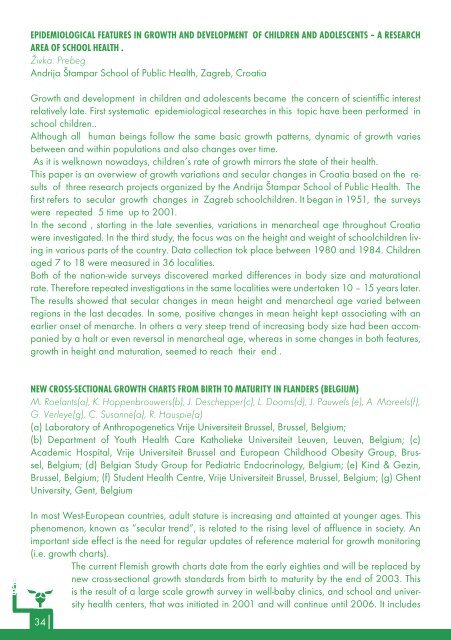abstract ok.indd - eusuhm
abstract ok.indd - eusuhm
abstract ok.indd - eusuhm
Create successful ePaper yourself
Turn your PDF publications into a flip-book with our unique Google optimized e-Paper software.
EPIDEMIOLOGICAL FEATURES IN GROWTH AND DEVELOPMENT OF CHILDREN AND ADOLESCENTS – A RESEARCH<br />
AREA OF SCHOOL HEALTH .<br />
Živka. Prebeg<br />
Andrija Štampar School of Public Health, Zagreb, Croatia<br />
Growth and development in children and adolescents became the concern of scientiffic interest<br />
relatively late. First systematic epidemiological researches in this topic have been performed in<br />
school children..<br />
Although all human beings follow the same basic growth patterns, dynamic of growth varies<br />
between and within populations and also changes over time.<br />
As it is welknown nowadays, children’s rate of growth mirrors the state of their health.<br />
This paper is an overwiew of growth variations and secular changes in Croatia based on the results<br />
of three research projects organized by the Andrija Štampar School of Public Health. The<br />
first refers to secular growth changes in Zagreb schoolchildren. It began in 1951, the surveys<br />
were repeated 5 time up to 2001.<br />
In the second , starting in the late seventies, variations in menarcheal age throughout Croatia<br />
were investigated. In the third study, the focus was on the height and weight of schoolchildren living<br />
in various parts of the country. Data collection t<strong>ok</strong> place between 1980 and 1984. Children<br />
aged 7 to 18 were measured in 36 localities.<br />
Both of the nation-wide surveys discovered marked differences in body size and maturational<br />
rate. Therefore repeated investigations in the same localities were undertaken 10 – 15 years later.<br />
The results showed that secular changes in mean height and menarcheal age varied between<br />
regions in the last decades. In some, positive changes in mean height kept associating with an<br />
earlier onset of menarche. In others a very steep trend of increasing body size had been accompanied<br />
by a halt or even reversal in menarcheal age, whereas in some changes in both features,<br />
growth in height and maturation, seemed to reach their end .<br />
NEW CROSS-SECTIONAL GROWTH CHARTS FROM BIRTH TO MATURITY IN FLANDERS (BELGIUM)<br />
M. Roelants(a), K. Hoppenbrouwers(b), J. Deschepper(c), L. Dooms(d), J. Pauwels (e), A. Moreels(f),<br />
G. Verleye(g), C. Susanne(a), R. Hauspie(a)<br />
(a) Laboratory of Anthropogenetics Vrije Universiteit Brussel, Brussel, Belgium;<br />
(b) Department of Youth Health Care Katholieke Universiteit Leuven, Leuven, Belgium; (c)<br />
Academic Hospital, Vrije Universiteit Brussel and European Childhood Obesity Group, Brussel,<br />
Belgium; (d) Belgian Study Group for Pediatric Endocrinology, Belgium; (e) Kind & Gezin,<br />
Brussel, Belgium; (f) Student Health Centre, Vrije Universiteit Brussel, Brussel, Belgium; (g) Ghent<br />
University, Gent, Belgium<br />
In most West-European countries, adult stature is increasing and attainted at younger ages. This<br />
phenomenon, known as “secular trend”, is related to the rising level of affluence in society. An<br />
important side effect is the need for regular updates of reference material for growth monitoring<br />
(i.e. growth charts).<br />
The current Flemish growth charts date from the early eighties and will be replaced by<br />
new cross-sectional growth standards from birth to maturity by the end of 2003. This<br />
is the result of a large scale growth survey in well-baby clinics, and school and university<br />
health centers, that was initiated in 2001 and will continue until 2006. It includes<br />
34




